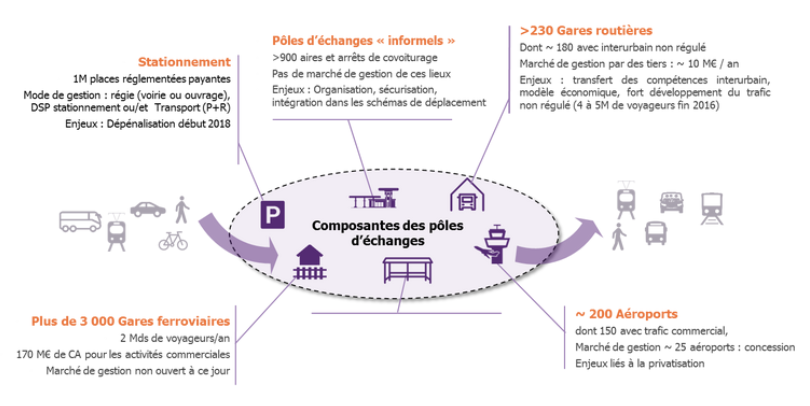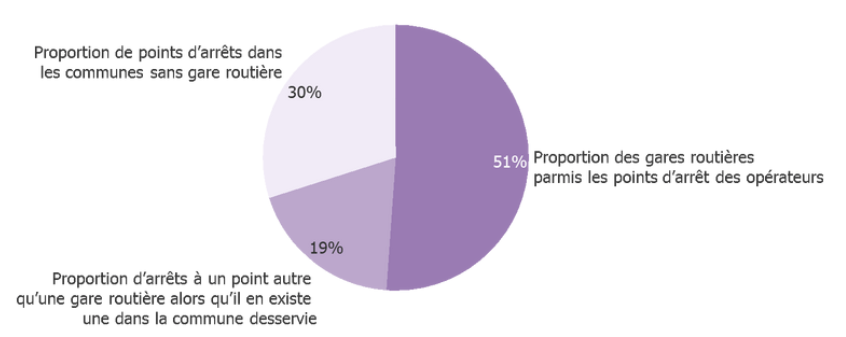The recent development of “Macron” coaches has highlighted the urgent need for modernization of bus stations, infrastructures long neglected by the public authorities. The transformation of mobility behavior and the increase in flows associated with these new transport services are putting connection nodes, and in particular bus stations, back at the center of concerns. Will they be synonymous with comfort and conviviality tomorrow?
NEW MOBILITIES CAUSE NEW INTERCONNECTION NEEDS, IN PARTICULAR FOR ROAD STATIONS
Public actors have long focused on the development of “online” transport infrastructures. The recent development of new modes of mobility has generated new interconnection needs between private modes and public transport modes. From now on, it is no longer a question of developing infrastructure, but of improving access and use by the various services that address mobility needs: carpooling, car-sharing, coach transport, public transport networks. Thus, investments are now focused on the nodes of the networks to adapt them to the growth in traffic and the needs of travelers (multiplication of PEM projects, investment in 3G / 4G / WiFi telecom infrastructures,development of shops in the main train stations, etc.) and in particular at bus stations.
These nodes are at the same time places of intermodality, life and services, and exist in different forms which all have their specificities [1]
NEW INTEREST FOR COACHES REPLACES ROAD STATIONS IN THE CENTER OF DEBATES
The law for growth, activity and equal economic opportunities, known as the “Macron” law of August 7, 2015, has changed the situation for coach transport. The deregulation of the sector has attracted investors wishing to find new markets. Anxious to mark a departure from “old-fashioned” coaches, the 3 major players in the market, Flixbus (independent German company, market leader), Ouibus (subsidiary of the SNCF operator) and Isilines (subsidiary of the operator Transdev) have endeavored to develop a modern image by investing in communication, in the design of equipment and by offering modern services, in particular via mobile applications.
More than a year later, it is clear that the “Macron” coaches have widely established themselves in the French transport landscape and that the opening of the market has been a success thanks in particular to an aggressive pricing policy. With 193 cities served by 257 regular lines making it possible to make 1105 separate direct connections * as of June 30, 2016 *, these new services quickly spread across the country and found their customers with more than 3.4 million passengers transported and € 40 million in turnover in less than a year, according to ARAFER [2]. Road passenger transport has seen an unprecedented evolution for 20 years.
A new market penalized by unsuitable bus stations
Not well suited to long-distance transport, particularly at night, bus stations are therefore faced with specific challenges linked to the growth of their activity, unlike airports or stations, for example, whose flows are generally stabilized. They therefore justify special attention with regard to the development of mobility services.
Long-distance road transport is characterized in terms of needs at the level of bus stations, compared to “classic” urban and interurban links, among others by:
- regulation times which may be longer;
- longer vehicles, with bunkers and requiring well-sized infrastructure to ensure safety and accessibility;
- major contingencies on travel times requiring greater flexibility of reception at the stopping point;
- the presence of toilets on board coaches requiring regular emptying;
- nocturnal services.
In addition, the significant increase in charges, in particular for new private operators, for access to medium-quality bus stations, may result in reorienting them to peripheral bus stations or to informal centers ( carpooling / P+R areas, shopping center parking).
Only 1 in 2 stops is inside a bus station [2]
Until now, the services have been organized around the existing infrastructures. This results in a strong heterogeneity of the services available in the bus stations. In order to standardize the quality of service and the safety of travelers, a decree, provided for in the ordinance, was published at the end of January. It specifies in particular the equipment and services that the facilities must offer “according to their characteristics, their level of frequentation or the nature of the traffic” . While this decree provides a first important clarification, the distribution of roles and responsibilities between the various Organizing Authorities and operators remains obscure (particularly on the subject of financing renovations).
AND YET THE INTEGRATION OF MACRON COACHES OFFERS NEW OPPORTUNITIES TO THE OWNERSHIP OF ROAD STATIONS
The “Macron” coaches, long imagined by regions and communities as a new competition for public transport, are finally proving to be a complementary mode. Indeed, these lines do not have the same schedules as departmental / regional interurban and do not target the same clientele as the train.
This new mode is also proving to be a simple way for communities to open up certain territories for which a train service is not very relevant (province-province exchange in particular). Local authorities therefore have every interest in organizing the reception and interconnection of this new mode with interurban and urban networks, by relying on the development of bus stations to pool and make the infrastructure profitable.
The development of long-distance coach journeys is thus a source of opportunities for the development and modernization of bus stations (use over different time frames from those of interurban and school). The need to modernize and develop bus stations is therefore the consensus among public actors. However, there has not yet been a concrete approach launched, the fault, no doubt, of an incomplete legal framework, a complex mode of governance and uncertainties about the services that will remain once the creation phase of the offer has passed. .
Maïeul Lombard
[Sources]
[1] PMP compilation from the following sources: INSEE, http://www.kelbillet.com/, http://www.comparabus.com/fr/, http://www.boamp.fr/, CERTU data.







